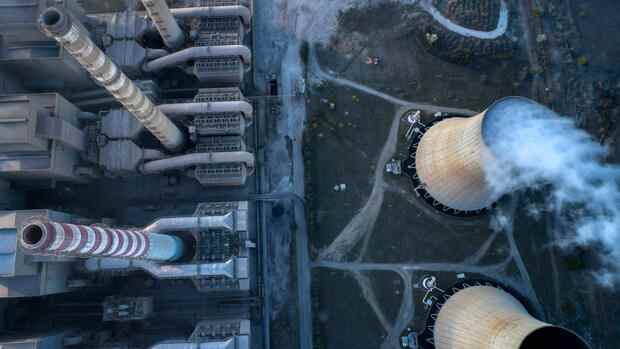Athens In September, Greece reduced its natural gas consumption by 40 percent compared to the same month last year. This was announced by Energy Minister Kostas Skrekas. The savings were made possible primarily through the increased use of lignite and diesel in power generation.
Despite the tense supply situation, the energy minister does not expect power cuts or rationing in the coming winter. This risk is “very low, almost zero,” said Skrekas on the TV station “Skai”.
To date, Greece has been heavily dependent on natural gas for electricity generation. Last year, Gasana’s share of the Greek electricity mix was around 40 percent. Almost two thirds of the annual consumption of 6.5 billion cubic meters of natural gas went into power generation.
In order to save expensive and scarce gas, the steam turbines of the lignite-fired power plants in Macedonia in northern Greece and on the Peloponnese peninsula are now running at full speed. Energy Minister Skrekas wants to double the share of lignite in power generation, which was eleven percent last year. In August it was already 24 percent.
Top jobs of the day
Find the best jobs now and
be notified by email.
Greece actually had ambitious goals when it came to phasing out coal. Prime Minister Kyriakos Mitsotakis wanted to phase out all coal-fired power plants by 2023 except for one, which was due to convert to natural gas in 2025.
>> Read here: “More damage than good”: SMEs are pushing for the gas levy to be abolished
Now the chimneys of the lignite-fired power plants at Kozani in northern Greece and at Megalopolis in the Peloponnese will smoke for at least another three years. The planned conversion of the most modern Greek coal-fired power plant Ptolemaida V to natural gas operation is also likely to be delayed until 2028.
First of all, Greece is now converting five gas-fired power plants that are technically possible to run on diesel fuel. This will require an additional 500,000 cubic meters of diesel in the coming winter.
Gazprom has not yet imposed any delivery restrictions on Greece
According to their own statements, the Greek refineries can produce this amount. According to industry experts, however, the continuous supply of power plants, which do not have much storage capacity, is difficult.
Major customer at Gazprom
40
percent of its gas imports
moved to Greece from Russia before the start of the war in Ukraine.
Before the start of the war in Ukraine, Greece obtained 40 percent of its gas imports from the Russian state-owned company Gazprom. The gas came via the Turkstream pipeline, which runs through the Black Sea to Turkey.
>> Read here: Risk of billions Margin calls – the underestimated problem in the energy crisis
Gazprom has not yet imposed any delivery restrictions on Greece. Despite this, the share of Russian deliveries in Greek gas consumption has halved to 20 percent this year, according to data from the network operator Desfa.
This was made possible primarily by the more intensive use of the LNG terminal Revithousa near Athens. Throughput at the liquid gas terminal has doubled compared to the previous year. The LNG delivered there in tankers comes mainly from the USA, Algeria and Qatar. According to the Ministry of Energy, Greece does not want to be surprised by a possible Russian delivery stop in winter and is therefore diversifying.
In June, the terminal operator Desfa had chartered a gas tanker as a floating storage facility. This increased the storage capacity in Revithousa from 225,000 to 370,000 cubic meters. Neighboring countries also benefit from this. According to Energy Minister Skrekas, Greece has exported two billion cubic meters of natural gas so far this year, up from 0.7 billion cubic meters in 2021.
Expansion for the way out
5.5
billion cubic meters
A new floating LNG terminal is said to have annual capacity, which is scheduled to go into operation at the northern Greek port of Alexandroupoli by the end of 2023.
Deliveries went mainly to Bulgaria and Italy. Bulgaria now gets most of its natural gas through the terminal near Athens after Gazprom stopped supplies to the country in the spring. The reason for the delivery stop was the refusal of the government in Sofia to pay for the Russian gas in rubles.
With new liquid gas terminals, Greece will become independent of Russian gas supplies
Without the Revithousa landfall, which was built in 1999 and has a capacity of 5.3 billion cubic meters per year, not only Greece but also Bulgaria would now be in a precarious situation.
At the end of 2023, another floating LNG terminal with an annual capacity of 5.5 billion cubic meters is scheduled to go into operation at the northern Greek port of Alexandroupoli. This will give the country enough terminal capacity to cover its own gas needs and those of neighboring Bulgaria and North Macedonia.
Even if the phase-out of coal is now delayed, the government is sticking to its climate goals. Greece wants to push the expansion of renewable energy sources with simplified approval procedures.
They already contributed 43.1 percent to electricity generation in the first five months of 2022, wrote Alexandra Sdoukou, Secretary General of the Ministry of Energy, in a guest article for the newspaper To Vima. The goal is a share of 70 percent by 2030. In an emergency program, the ministry wants to have 250,000 new photovoltaic panels installed by the end of this year, 150,000 of them on the roofs of residential buildings and 75,000 each on commercial areas and farms.
More: Why doesn’t Germany just frack its own gas?
